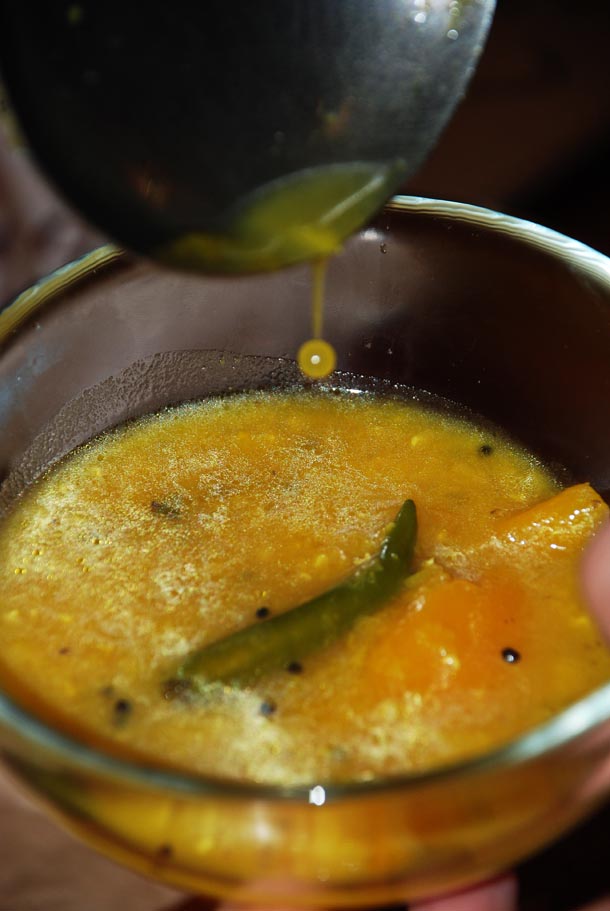
Summer is slowly waltzing into Dubai. A few more days and suddenly the Celsius scale would be touching the 40s on a regular basis. I have spent so many summers in Dubai, yet the temperature in any random summer day still shocks me every time I know the exact magnitude of it. Conversations with other mums on school runs during the summer while picking up the Z-SISTERS sound typically like these – ‘My God, isn’t it really hot today?’ or ‘Did you see the temperature today? It is 40!’ or ‘Really? It’s 40 already? But it’s not even May!’
Do all Dubai-ites have this annual short-term amnesia? Or is it only me? Why does it surprise me so much when the temperatures eventually soar high? Do I expect anything else? Or am I too lazy to make new conversations? Whatever be the case it does give me the excuse to resort to some traditional kitchen remedies to cool my body temperature down. One such traditional Bengali remedy is Mango Lentil Soup or Aam Dal. And before the green mangoes in the supermarkets ripen up and turn yellow let me share the little secret of every Bengali Granny’s summer Dal recipe.
After staying outside Bengal for many years I have realised that the world today has indeed become a smaller place. Our palates have become very flexible and international. There is no need to worry about the global acceptance of a Bengali Aam Dal or a major write-up into the history of Indian Dal making.
This is a very easy recipe and many a times I have served it successfully to my non-Indian friends with very minor modification. Moreover, not to forget that the green mangoes also have a therapeutic value in keeping the body temperature down. And that is precisely why the recipe originated in the sweltering summer heat in some Bengali kitchen.
Following are the characteristics of all recipes doling out of our little hands, big hearth –
♥ Easy to cook
♥ Regular canned products off the shelf may be used (However, we advocate using fresh products)
♥ Goes well both as a regular or party dish
♥ Children can easily help in making the dish (My two little sous-chéfs are aged 8 and 3 years!)
♥ And lastly, guaranteed to be tasty!
Mango Lentil Soup/ Aam Dal
Category – Veg Side-Dish ; Cuisine type – Traditional Bengali
The Mango Lentil Soup or the Aam Dal is sweet as well as sour in taste (not the same sweet and sour taste of Chinese Cuisine!) and doesn’t have a thick consistency like other traditional Indian Dals. It may be served cold but this varies from each household to the other and is supposed to possess enormous cooling properties during summer.
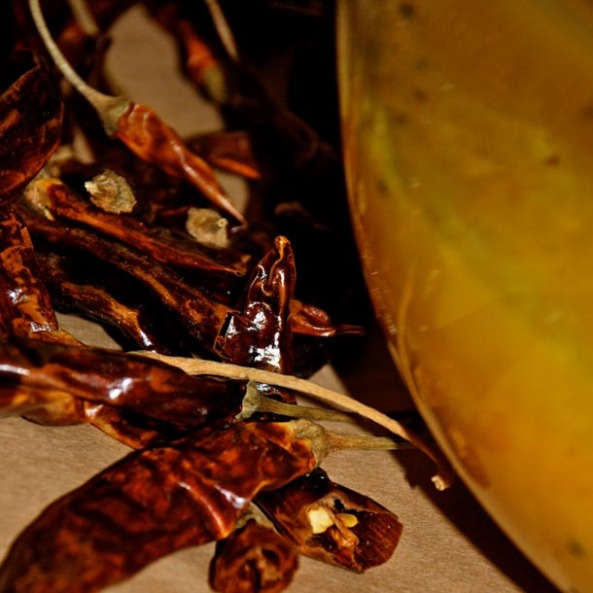
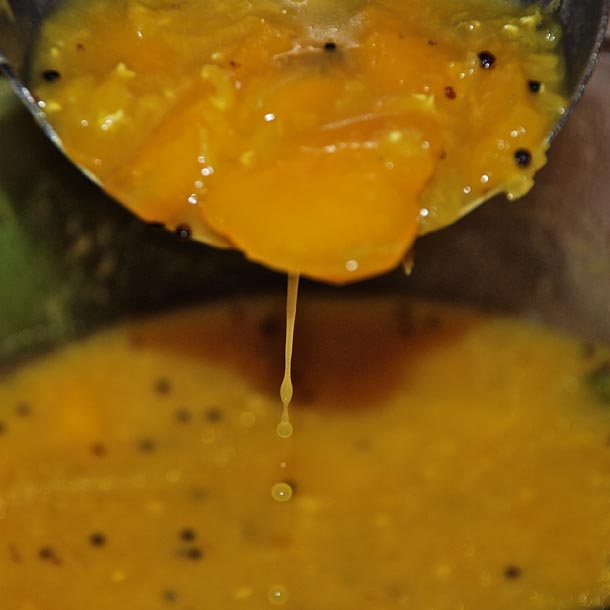
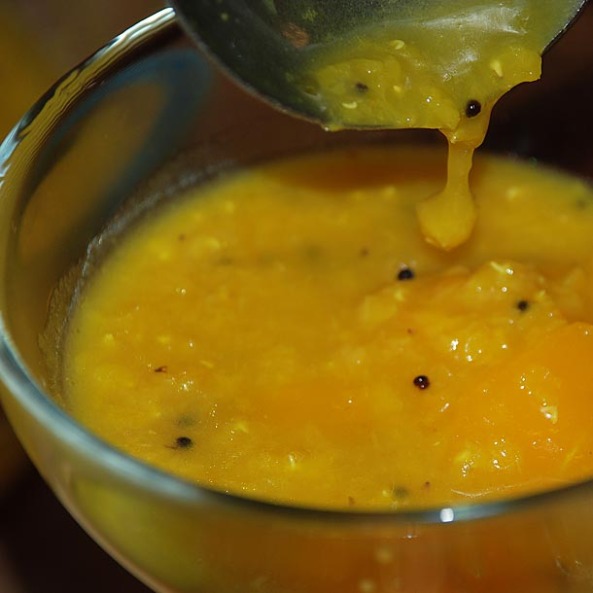
For the printable recipe→
Serves 6-8
Preparation time: 1 hr 30 minutes (boiling the Dal – 1 hr; cooking – 30 minutes maximum)
Ingredients:
Masoor Dal/Orange Lentils – 1/2 cup
Green Mangoes – 2 medium, peeled and sliced longitudinally
Mustard Seeds – 1 tsp
Dried Red Chillies – 3
Green Chillies – 2 (optional)
Turmeric Powder – 1/2 tsp
Salt – 1 tsp
Sugar – 1 tsp
Mustard Oil – 1tsp
Method of Preparation
– Boil the Orange Lentils in 5 cups of water along with green chillies and turmeric powder or Pressure cook the same. If you wish to boil the Dal or use a Microwave then make sure you adjust the water occasionally so that the Lentils don’t become dry
– Heat the Mustard Oil in a deep frying pan
– Add mustard seeds and dried red chillies. When they begin to splutter add the sliced mangoes including the mango seeds
– Add the boiled Lentils once the mangoes become a bit soft
– Cover and let it simmer on very low heat for fifteen minutes (You may have to add more water to make it more soupy)
– Add the sugar and a bit of salt if required (it should taste sweet-sour) and let it cook for 5 more minutes
Accompaniment
Serve hot or cold with plain white Rice or serve it like a soup
A non-traditional adjustment
Many of my friends who are not so accustomed to Bengali Cuisine or Indian Cuisine for that matter find the Mustard seeds come in the way of appreciating the taste of the Dal. For them I have often removed the seeds or used a sieve while making sure that I stir in enough mango pulp to retain the original flavour of the Dal. Occasionally. I have added 1/2 cup of low-fat cream to thicken the consistency. Though the Dal loses it’s authenticity it also becomes widely palatable. Maybe this would call for a sequel in the future.
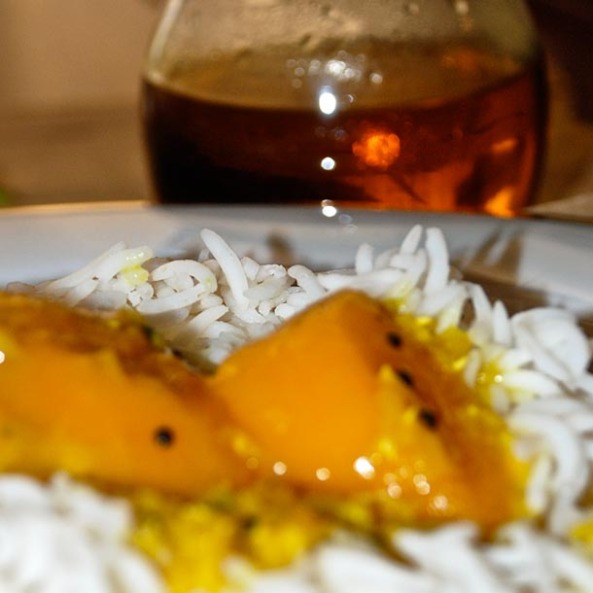
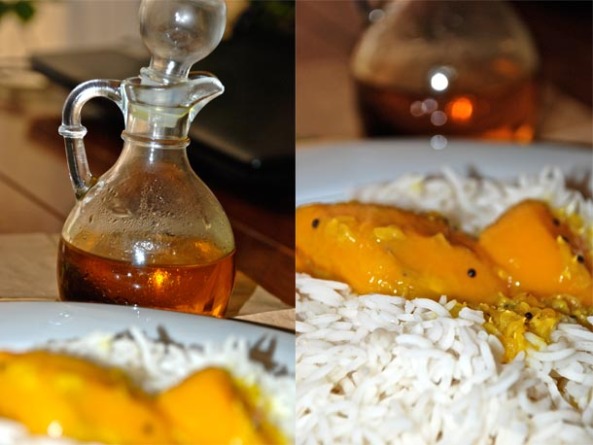
Variation:
Many prefer to cook the Lentils separately with the Mangoes and pour the spluttering Mustard seeds and the dried red chillies in Mustard Oil as a finishing touch. The adding of Mustard Seed or any other seeds in oil is called Phoron in Bengali and Chaunk or Bagar in Hindi. Paanch Phoron is a traditional assortment of 5-Spice seeds slightly cooked in very hot oil and then added to a Bengali dish for a unique taste and aroma.
The cooking technique of tempering is quite typical to Pakistani, Indian and Bangladeshi Cuisines, the type of seeds going into the tempering varying from region to region and from one dish to the other.
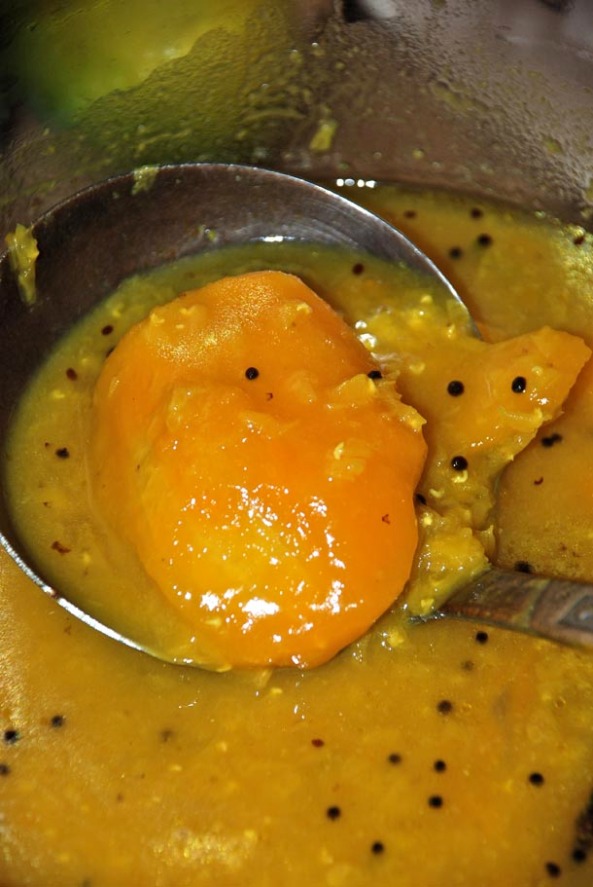
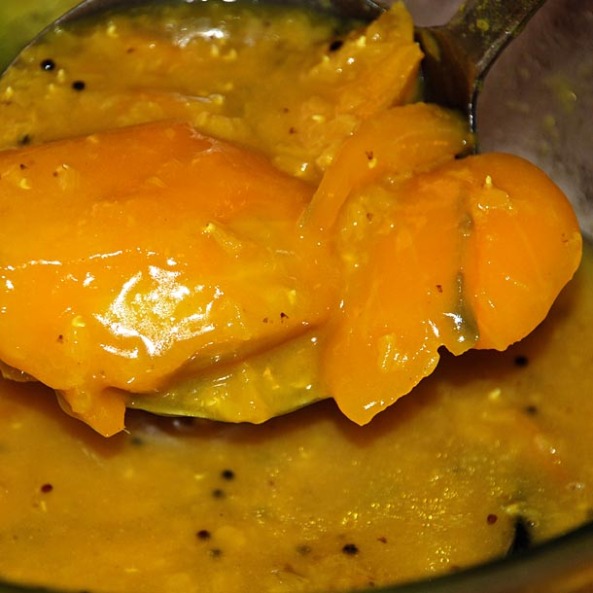
Nostalgia unfolds with the Aam Dal as I venture upon my photographic journey into the making of it. Each day my objective is to surpass the photographer that I was of the previous day. With each subject the number of photographs increasingly pile up as I try to incorporate whatever I’m learning from the various books on photography that I keep on reading. A shocking 130 photographs only on today’s subject. Phew! Now I have assigned Big Z with the responsibility that she should snatch my camera away after she hears the 20th click on a particular subject.
Biting into the pulp of the mango as well as savouring the mango seed till the last juicy drop of Dal comes out – that has to be the objective if you are cooking this Dal and serving it on the dining table for your dear family. The Weekend Review of this week’s Gulf News has an article which states that ‘the remedy for a fast-paced world will be to convert the simplest of acts like eating into a mindful gesture…’ and ‘to pay close attention to the sensation and purpose of each morsel’.
I would request you to incorporate that philosophy into your meal experiences. If not for anything else but atleast for this Aam Dal. The Aam Dal can’t be savoured justifiably on the go. Each sip or a spoonful with plain white rice should go into the system slowly, one sip at a time, one spoon at a time!
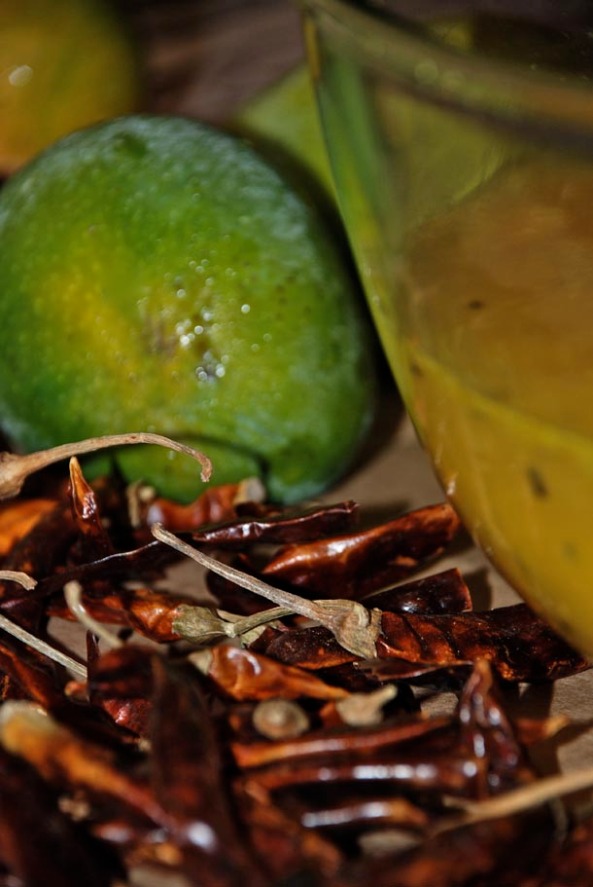
The story of This Side and That Side
This is an interesting aspect of Bengalis which calls for a lot of controversy and has given rise to many a literary or intra-family debates. When India attained her independence in 1947, Bengal got divided into two parts – one part falling into India and the other part falling into Pakistan which was known as East Pakistan. in 1971 East Pakistan became Bangladesh when the later seceded from Pakistan.

A lot of families were scattered between these two portions (if I may borrow the term from food terminlogy!) of Bengal.
For a Bengali residing in the Indian portion of Bengal, Bengal in India is Epar Bangla (Bengal on This Side!) and a person hailing from this side is colloquially referred as a Ghoti.
And the portion of Bengal that falls in Bangladesh is Opar Bangla (Bengal on That Side!) and a person whose ancestors originally hailed from ‘that side’ is termed as a Bangal.
Bengali is spoken in both sides but the dialect and the accent differs drastically. So does food habits and cultural orientation.
I am a Ghoti but my husband is a Bangal. The fish dishes cooked in my in-laws’ place are very different from what I have grown up eating. So are some of the Dals cooked. Aam Dal is eaten here at the end of a meal and not in the beginning of a meal as other traditional Dals!
There is a major debate as to who are better cooks. I love eating good food – whether it is from this side or that side or from the middle. I have incorporated both the styles of cooking in my life and in my opinion there’s no point getting into a debate as to which side cooks better. Simply enjoy both as that will give you more options in life!
Map Courtesy – Web (though I take the credit of a drastic make-over!)
The story of This Side and That Side breaks down in a foreign land
The so-called Ghoti-Bangal debate has no significance when Bengalis (whether from India or from Bangladesh) are living thousands of miles away from their original homelands. When I walk into a supermarket and a Bangladeshi assistant hears me speaking in Bengali to Big-Z or Li’l Z, one of the most likely string of conversations that might follow sounds like this –
‘Apni ki Bangali?/Are you a Bengali?’ and then ‘Kothakar? Kolkatar?/From where?From Kolkata?’ and finally ‘Amio Bangali. Bangladyasher/ I am a Bengali too. From Bangladesh’.
Then there will be a series of information swapping.
From his side: How long am I here? Do I work here? How often do I go to Kolkata? Have I ever been to Bangladesh?
From my side: How long is he here? How long is he working? How old are his children? Do they go to school?
And then the most probable final question from his side: Dada kothay kaaj koren?/Where does Brother work?’ where Brother respectfully indicates my husband!
It’s amazing how this geographical border erases out in a foreign land. I have had the same experience every time I have come across anyone from Bangladesh. And why should there be any difference? After all Rabindranath Tagore, the greatest poet in Bengali literature, a Nobel laureate, has penned both the Indian national anthem as well as the Bangladeshi national anthem. Bengalis the world over have more common things to share than just common songs and common tunes!
Identifying myself at a macro level
When Srilanka became our home a decade ago, I used to seek out for Indians, thus broadening my horizon from Bengal. When we set up home in Dubai I started seeking out for Indians and Srilankans. When we moved to Frankfurt and set up our home there, I started seeking out for Indians, Srilankans and anyone from Dubai or having an UAE connection. When we came back to Dubai once again I started seeking out for Indians, Srilankans and Germans. I am slowly becoming multi-cultural and I realise that I am on my journey to become a global citizen. While doing so I haven’t had to shed my old feathers but have just kept on adding new feathers as I grew.
Unblogging it all… Ishita
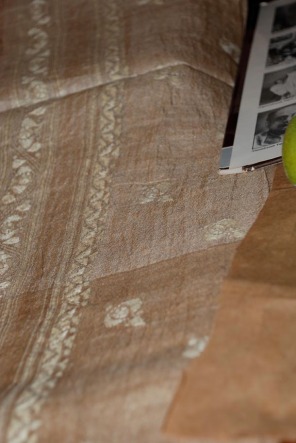


You may want to venture into my photographic journey into the making of Aam Dal.
Other Recipes
Daal Maharani Befitting the Queen (And Also Us)
Sikarni Raan/Marinated Lamb Shank from Yak & Yeti
Easter Egg Curry Cooked By Easter Bunnies!
Mashed Potato Bengali Style/ Aloo Bhaaté
Related Articles over the web
Dal/Lentils
History of Bengal
History of Bangladesh


Lovely. Enjoyed the write up. Am going to be making it. Thanks for sharing
LikeLike
Aditi – Thanks a lot! Summer calls in for all these traditional recipes, isn’t it?
LikeLike
A very nostalgic dish for me. Now I’ll have to look for Kacha aam. 🙂
LikeLike
I’m sure you’ll get loads of it there. BTW, as I have mentioned in the post that we share this Aam Dal between the Bengalis of India and Bengalis of Bangladesh – but this was our version of a Dal which originated in your side. Do you also cook it the same way? Or is it very different?
LikeLike
Very similar. Sometimes with Panch Phoron instead of just the mustard seeds. It’s sucking on the seeds that makes it the best!
LikeLike
Paanch Phoron is used by us as well. Probably I should have mentioned that! Editing each post is such a headache – I wish we could just put some add-on yellow stickies to each post!
LikeLike
Scrumptious! I often use aamchur powder to tang up my daal but using kacha aam sounds far more promising! Will definitely make it when i go home to Pakistan for the summer. Kacha aam are easily available there! 🙂
LikeLike
Kacha Aam will give a different taste to your Daal than Aam Chur. Do you have traditional Dal recipes in Pakistan which make use of Kacha Aam? This recipe is probably shared by Bengalis living both in India and Bangladesh. Do let me know about your Kacha Aam hunt!
LikeLike
Pingback: Dates Set for the Fourth Annual Mango Festival « Hawaii News and Island Information
Oh my gosh ! looks AMAZING! I love Mangoes ( obviously) and love lentils too! which is a staple at home! this is a marriage made in heaven ! well i know what is going on my friday menu now 🙂
LikeLike
Shafeena – thanks so much! I took away all the stress out of planning Friday lunch… On second thoughts should I demand a treat? Do let me know how it went:)
LikeLike
isssshhhhh … loved the recipe and the pre . post details , variations and history ,, i think i ll stick to the traditional bangla version of daal :))))) although its the official start of winters here . but luckily we ve sour raw mangoes whole year round , so i ll happily let my body temorature go evn more down with this yemmilicios daal .
ASANTESANA MAMA ISSSSSHHHHH 🙂
LikeLike
KARIBU MAMA POO!
Raw mangoes have very good properties – lucky you to get them all the year around. Do suggest some local easy recipe – may be a salad or something? I shall try it and post it – a guest recipe from the other hemisphere!!!
LikeLike
Pingback: Cumin Beetroot Cold Salad – A Summer Salad «
Pingback: Easter Egg Curry Cooked By Easter Bunnies! «
Pingback: Mashed Potato Bengali Style/ Aloo Bhaaté «
Pingback: Bengali Sweets That Came By Parcel! «
Pingback: Rasgulla Macapuno – When a Filipina Turns Bong! «
Another wonderful post Ishita!
You might want to look at splitting your posts. While a very long post is daunting, people for some reason will easily read two short posts! Your entire post was too interesting for people to have to skim it without reading it fully. Just a thought 🙂
LikeLike
I have thought about it but do readers actually drift between two posts? About myself – suppose I chance upon the 2nd part for the first time I’ll go back to the earlier post that contains first part. But if I chance upon the 1st part I might not come back for the 2nd part. In general I’ve been thinking abt this – but each one has an interlinked story for me to break it up. If a celebrity is writing it’s different thing altogether – readers are anyway waiting. However I am slowly getting readers who are probably looking forward to my posts. I’ll keep your suggestion definitely in mind. So appreciate this – really:)
LikeLike
You do have a point. Was just thinking how rushed most other bloggers are. For other readers your way is definitely better.
LikeLike
Pingback: Meydan Fireworks & Yoghurt Aubergine «
Pingback: Featured in Foodie BlogRoll & Green Mango Chutney! «
Pingback: Authentic Bengali Cuisine… In ‘Slight’ Details «
Pingback: Rasgulla Macapuno On TV & Shubho Bijoya to all! «
Pingback: Living By The Water With Sunset As Prop – Kolkata & the Ganges «
Pingback: Semaiya Kheer/Vermicelli Pudding, Eid in Dubai… Eid Mubarak! «
Pingback: Frozen Aam Pana/Green Mango Pulp… The Change Initiative Inspiration! «
Pingback: Gajorer Payesh/Carrot Pudding… Wishing Everyone A Happy Diwali! «
Pingback: Notun Gurer Payesh/Traditional Bengali Rice Pudding & My Dida «
Pingback: Shondesh/Sandesh Pudding… Guest Post For Sudeshna From Cook Like A Bong! «
Pingback: Shorshe Bata Maach – Mustard Salmon In This Case | A Detour From Thailand To Wish Shubho Noboborsho! |
Pingback: Blog Turns 2 | A Chance To Meet Masterchef Sanjeev Kapoor For 2 Lucky Readers! |
Pingback: When The Mango Is The Hero in A Love Story | Mahec, Le Meridien |